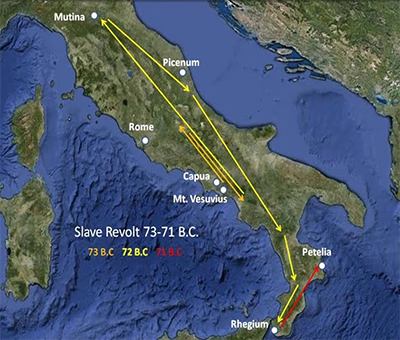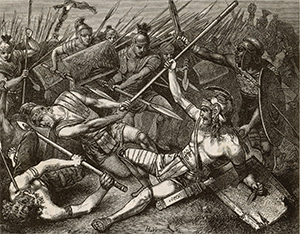Spartacus: Slave Rebel against Rome
He was perhaps the most famous Roman gladiator ever. His name was Spartacus, and he led a slave rebellion against the might of Rome in the early 1st Century B.C. 
Sources differ on some of the details of his life, including the year of his birth. Most sources list him as being born about 100 B.C. in Thrace, which Rome had assumed responsibility for after conquering Macedon and from which Rome acquired a large number of slaves. Spartacus is thought to have fought as an auxiliary soldier in the Roman Army for a time and then deserted, after which he was captured and sold into slavery. Some sources name his "owner" as Vatia. One person whose name is known is that of Lentulus Batiatus, who ran the gladiator school near Capua to which Spartacus was sent. In 73 B.C., Spartacus escaped, seizing knives and other weapons. Escaping with him were several dozen others who were being trained as gladiators. (One source, Plutarch, says that Spartacus was married that his wife escaped with him.) The escaped gladiators made their way to Mount Vesuvius. As they went, they foraged for supplies and from the villages along the way recruited slaves who wanted a taste of freedom. By the time the escapees reached the famous mountain, their numbers had swelled to a few thousand. At the time, the main Roman armies were nowhere to be found. The Republic was busy fighting wars in Crete, what is now southeast Europe, and what is now Spain. The Roman praetor Gaius Claudius Glaber formed an ad-hoc army and surrounded the mountain, planning on a siege in order to convince the escapees to surrender. The enterprising Spartacus–along with two others who took a leading role in the rebellion, Crixus and Oenomaus–led the force in using vines to abseil down the mountain and surprise the Roman soldiers at the bottom. The shocked Romans fled, leaving their camp behind, and the slaves had a new source of food and supplies. 
Spartacus and the army roamed the countryside, finding more and more people who wanted to join the fight, providing not just manpower but also food, supplies, and even money. In time, many people who weren't slaves joined up. By early 72 B.C., sources estimate that the armed force numbered some 40,000. Rome responded with force, sending a force of 10,000 well trained troops under each of the two consuls, Gnaeus Cornelius Lentulus Clodianus and Lucius Gellius Publicola, to hunt down and confront the runaway slaves, who had split their forces and gone different directions. Spartacus and a large part of the force marched north toward the Alps; Crixus and the rest of the slaves stayed in south Italy. Gellius and his man killed Crixus and a good number of his force in a pitched battle, then marched north, hurrying to catch up with Lentulus, who was approaching Spartacus's force from the north. The rebellious slaves faced the prospect of being trapped between seasoned armies. Turning the tables, Spartacus ordered an attack, carrying the day with a fierce cavalry charge that sent the Roman force flying. Again, the runaway slaves seized a large amount of supplies. The inspired slaves then defeated Gellius's force as well and continued north. The Roman custom wasn't to admit defeat and move on, and so the Senate sent another large force, under Gaius Cassius Longinus. Spartacus and his force won that confrontation as well and reached the base of the Alps. At this point, however, they turned around. Historians do not agree on why. By this time, Rome had had enough of the rebellion and enlisted Marcus Licinius Crassus to solve the problem. A very wealthy individual, he was praetor at this time and used a large amount of his own money to finance and equip a large army with which to confront the rebellious slaves. The result was a force 10 legions strong, with more than 40,000 soldiers who were expertly trained and expensively equipped. Spartacus's force by this time had diminished from its high of 70,000. They marched back south, beating back challenge after challenge, until they reached the Strait of Messina. The goal at this point was to sail to Sicily. Spartacus made a deal with what Plutarch called "Cilician pirates," who took payment and then sailed away, denying passage. Spartacus and his men built a number of boats themselves, but the crossing turned into a disaster and the army had to abandon the plan. In 71 B.C., the two forces confronted each other. Spartacus, learning that even more legions under Pompey were on their way home from Spain, tried to negotiate some sort of peace agreement with Crassus. The latter refused. At this point, a considerable number of the slave army fled; Crassus dispatched a force that caught them and killed them. 
Spartacus then ordered an all-out attack. In the grand melee that followed, deaths were many on both sides. Spartacus and his force, however, were defeated, with their leader losing his life on the battlefield. The remnants of the slave army surrendered, and Crassus rewarded this act by having 6,000 of them crucified and displayed along the Appian Way from Rome to Capua. Despite his defeat and death, Spartacus served as inspiration for future rebellions, including that of the Haitians against France in the late 18th Century. Crassus and Pompey, meanwhile, went on to different fates, at one point joining together with Julius Caesar to run the government as the First Triumvirate. |
|
Social Studies for Kids
copyright 2002–2025
David White




